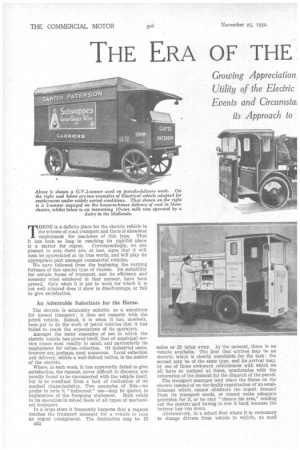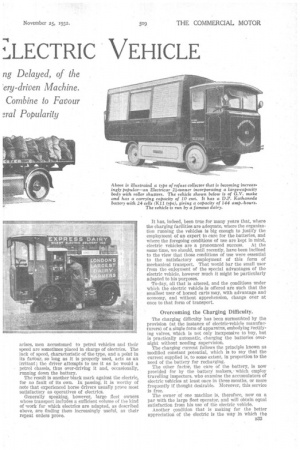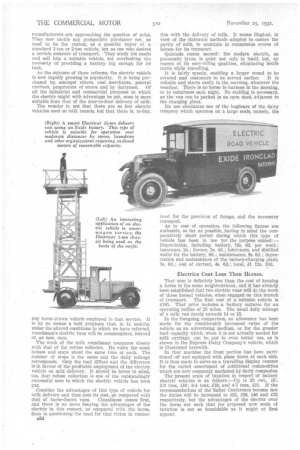THE ERA OF THE IECTRIC VEHICLE
Page 50

Page 51

Page 52

If you've noticed an error in this article please click here to report it so we can fix it.
Growing Appreciation. Utility of the Electric Events and Circurmta its Approach to ng Delayed, of the 'cry-driven Machine. Combine to Favour 2ral Popularity
THERE is a definite place for the electric vehicle in the scheme of road transport and there is abundant employment for machines of this type. That it has been so long in reaching its rightful place
Is a matter for regret. Correspondingly, we are pleased to note there are, at last, signs that it will soon be appreciated at its true worth, and will play its appropriate part amongst commercial vehicles.
We have followed from the beginning the varying fortunes of this special type of chassis. Its suitability for certain forms of transport, and its efficiency and economy when employed in that manner, have been proved. Only when it is put to work for which it is not well adapted does it show to disadvantage, or fail to give satisfaction.
An Admirable Substitute for the Horse.
The electric is -admirably suitable as a substitute for horsed transport ; it does not compete with the petrol vehicle. Indeed, it is when it has, unwisely, been put to do the work of petrol vehicles that it has failed to reach the expectations of its operators.
Amongst the many examples of use in which the electric vehicle has proved itself, that of municipal service comes most readily to mind, and particularly its employment for refuse collection. Of industrial users, brewers are, perhaps, most numerous. Local collection and delivery, within a well-defined radius, is the m4Stier of the electric.
Where. in such work, it has apparently failed to give satisfaction, the reasons, never difficult to discover, are usually found to be unconnected with the vehicle itself, but to be resultant from a lack of realization of its marked characteristics. Two examples of this—we prefer to term it " indiscreet " use—may be quoted, in explanation of the foregoing statement. Both relate to its operation in mixed fleets of all types of mechanical transoort.
In a large store it frequently happens that a request reaches the transport manager for a vehicle to take an urgent consignment. The destination may be 15
B32 miles or 20 miles away. At the moment, there is no vehicle available. The first: that ;arrives may be an electric, which is clearly unsuitable for the task : the second may be of the same type, and its arrival may, by one of those awkward coincidences with which we all have to contend at times, synchronize with the reiteration of the demand for the dispatch of the parcel.
The transport manager may place the blame on the electric instead of on the faulty organization of an establishment which cannot eliminate the urgent demand frpm its transport 'needs, or cannot make adequate provision for it, or he may "chance his arm," sending out the electric and having to tow it back because the battery has run down.
Alternatively, in a mixed fleet where it is customary to change drivers from vehicle to vehicle, as need
arises, men accustomed to petrol vehicles and their speed are sometimes placed in charge of electrics. The lack of speed, characteristic of the type, and a point in its fajour, so long as it is properly used, acts as an irritant ; the driver attempts to use it as he would a petrol chassis, thus over-driving it and, occasionally, running clown the battery.
The result is another black mark against the electric, for no fault of its own. In passing, it is worthy of note that experienced horse drivers usually prove most satisfactory as operatives of electrics.
Generally speaking, however, large fleet owners whose transport includes a sufficient volume of the kind of work for which electrics are adapted, as described above, are finding them increasingly useful, as their repeat orders prove. It has, indeed, been true for many years that, where the charging facilities are adequate, where the organization running the vehicles is big enough to justify the employment of an expert to care for the batteries, and where the foregoing conditions of use are kept in mind, electric vehicles are a pronounced success. At the same time, we should, until recently, have been inclined to the view that those conditions of use were essential to the satisfactory employment of this form of mechanical transport. That would bar the small user from the enjoyment of the special advantages of the electric vehicle, however much it might be particularly adapted to his purposes.
To-day, all that is altered, and the conditions under which the electric vehicle is offered are such that the smallest user of horsed carts may, with advantage and economy, and without apprehension, change over at once to that form of transport.
Overcoming the Charging Difficulty.
The charging difficulty has been surmounted by the provision (at the instance of electric-vehicle manufacturers) of a single form of apparatus, embodying rectifying valves, which is not only inexpensive to buy, but is practically automatic, charging the batteries overnight without needing supervision. The charging current follows the principle known as modified constant potential, which is to say that the current supplied is, to some extent, in proportion to the need of the battery for recharging.
The other factor, the care of the battery, is now provided for by the battery makers, . which employ travelling inspectors, who examine the accumulators of electric vehicles at least once in three months, or more frequently if thought desirable. Moreover, this service is free.
The owner of one machine is, therefore, now on a par with the large fleet operator, and will obtain equal satisfaction from his use of the electric vehicle.
Another condition that is making for the better appreciation of the electric is the way in which the manufacturers are approaching the question of sales. They now tackle any prospective purchaser not, as used to be the custom, as a possible buyer of a standard 1-ton or 2-ton vehicle, but as one who desires a certain measure of transport. they study ills needs and sell him a suitable vehicle, not overlooking the necessity of providing a battery big enough for its task.
As the outcome of these reforms, the electric vehicle is now rapidly growing in popularity. It is being purchased by, amongst others, coal merchants, general carriers, proprietors of stores and by dairymen. Of all the industrial and commercial purposes to which the electric Might with advantage be put, none is more suitable than that of the door-to-door delivery of milk.
The wonder is, not that there are so few electric vehicles used on milk rounds, but that there is, to-day, any horse-drawn vehicle employed in that service, It is by no means a bold prophecy that, in 12 months, under the altered conditions to which we have referred, roundsmen's electric vans will be commonplace, instead of, as now, rare.
The work of the milk roundsman compares closely with that of the refuse collector. He visits the same houses and stays about the same time at each. The number of stops is the same and the daily mileage corresponds. Only the load differs and the difference lain favour of the profitable employment of the electric vehicle on milk 'delivery. It should be borne in mind, too, that refuse collection is one of the outstandingly successful uses to which the electric vehicle has been put.
Consider the advantages of this type of vehicle for milk delivery and then note its cost, as compared with that of horse-drawn vans. Cleanliness comes first, and there is no more denying the advantages of the electric in this respect, as compared with the horse, than in questioning the need for that virtue in connec B34 tion with the delivery of milk. It seems illogical, in view of the elaborate methods adopted to ensure the purity of milk, to maintain in commission scores of horses for its transport.
Quietude comes second: the modern electric, on pneumatic tyres, is quiet not only in itself, but, by reason of its easy-riding qualities, eliminating bottle rattle while travelling.
It is fairly speedy, enabling a larger round to be covered and customers to be served earlier. It is reliable and starts easily in the morning, whatever the weather. There is no horse to harness in the morning, or to unharness each night. No stabling is necessary, as the van can be parked in an open shed, adjacent to the charging plant.
Its use eliminates one of the bugbears of the dairy company which operates on a large scale, namely, the
need for the provision of forage, and the necessary transport.
As to cost of operation, the following figures are authentic, so far as possible, having in mind the comparatively short period during which this type of vehicle has been in use for the purpose named :— Depreciation, including battery, 13s. 6d, per week ; insurance, 2s, ; licence, 2s, 4d.; lubricants, and distilled water for the battery, 6d.; maintenance, 8n lid.; depreciation and maintenance of the battery-charging plant, Is. 6d.; cost of current, 4s. 6d.; total, £1 12s. 10d.
Electries Cost Less Than Horses.
That sum is definitely less than the cost of keeping a horse in the same neighbourhood, and it has already been established that two electric vans will do the work of three horsed vehicles, when engaged on this branch of transport. The first cost of a suitable vehicle is £185. That price includes a battery suitable for an operating radius of 25 miles. The usual daily mileage of a milk van rarely exceeds 14 or 15.
In the foregoing comparison, no allowance has been made for the considerably increased value of the vehicle as an advertising medium, or for the greater load capacity which, when it is not actually needed for milk carriage, can be put to even better use, as is shown in the Express Dairy Company's vehicle, which is illustrated herewith.
In that machine the front portion has been partitioned off and equipped with glass doors at each side. It is thus made to serve as a travelling display counter for the varied assortment of additional commodities which are now commonly marketed by dairy companies.
The present scale of taxation in respect of battery electric vehicles is as follows :—Up to 25 cwt., £6; 2-3 tons, £16 ; 3-4 tons, £19, and 4-5 tons, 121. If the recommendations of the Salter Conference become law the duties will be increased to £22, £39, £46 and £72 respectively, but the advantages of the electric over the horse are such that the proposed new scale of taxation is not so formidable as it might at first appear.




































































































